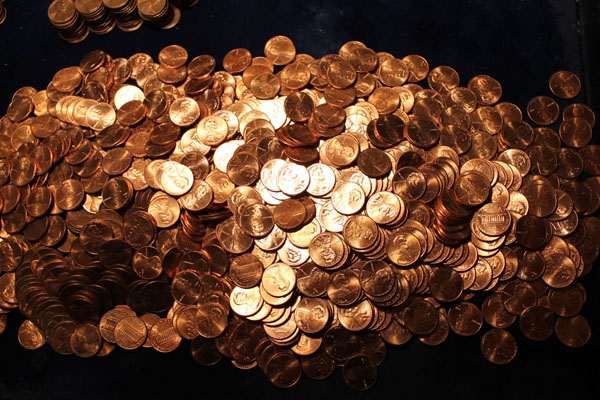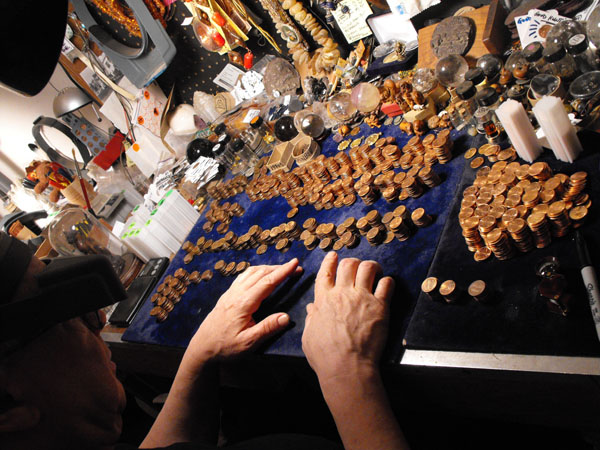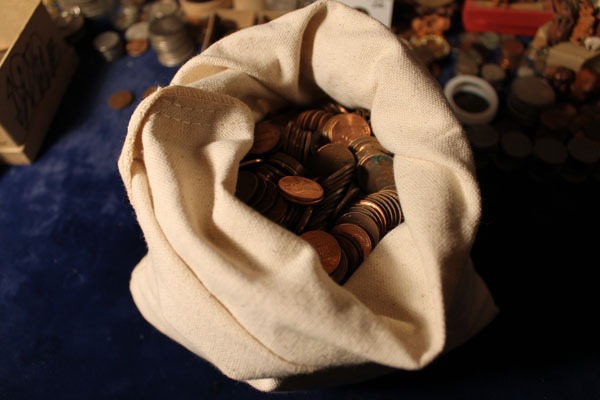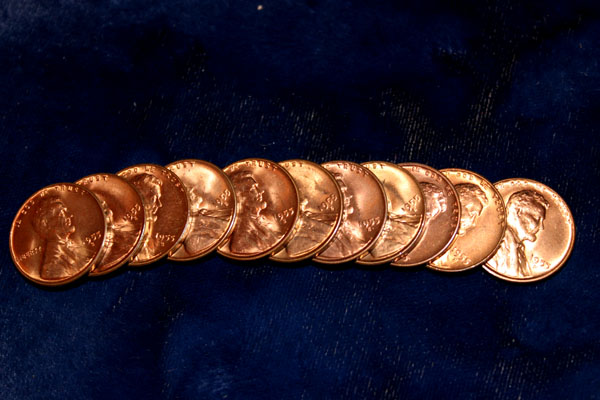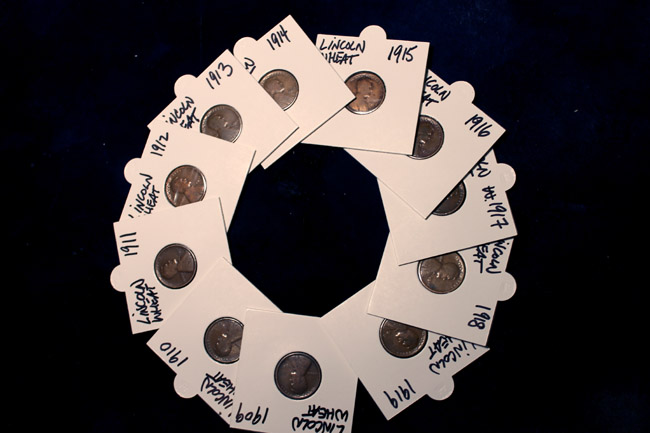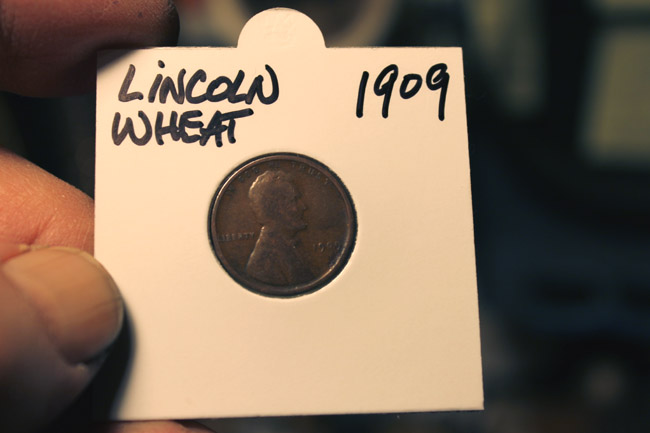What is a “Gorby’s Penny-Picker Cash Cow”, and why would I want one?
Okay, fair question, and here’s the best answer I can give you at the moment — a Penny Picker Cash Cow is a fair booth. Of course, it can be applied anywhere, in a store, apartment or traveling bus.
First of all, don’t bother to register the concept — it’s not new, but it might be new to you, which is, technically, new.
So, of what precisely does a Penny Picker Cash Cow consist?
First of all, shouldn’t you be asking whether this Cash Cow is a Work Thing or a Business Thing?
Well, it’s both. You earn a livelihood from your Bodhisattva work, and it takes several very specific forms — obtaining coins, sorting coins, searching coins, grading coins, packaging coins, selling coins and teaching coin search to others.
When you send in your $450, I buy a bag of wheaties and search them to cherry-pick anything EF and above, and put those in a different container. The lesser quality coins are placed in your “Search Bag” or “Go Fish Bowl” in your fair booth or shop or waiting room.
You receive the following items:
- One Bag of Wheaties type U.S. pennies in assorted dates from 1909 to 1958, and all different conditions from Good all the way to perhaps Extra-Fine, if I missed a few pickers, which I’ll explain in a moment. Your bag will contain mint-marks, which usually cost a lot extra.
- One Bag of higher-grade EF-AU BRN Wheaties that might range anywhere from 1909 to 1958 — it’s totally random, so you don’t really know what to expect. You’ll be putting these in self-sealing — which means no staples — “flips”, which you can order directly. A box of 1000 flips from my supplier will cost wholesale exactly $125 plus shipping. You’ll also be pricing these, with the 2017 Mega Red Book. Don’t get the 3rd edition — it has no photos and is less easy to use than the 2017. The prices aren’t that different for this level of coin that you’ll be finding and handling and selling.
You need no more than this to get started.
There are several ways in which to make the Cash Cow work. You have several types of coins that will emerge from your two bags of wheaties.
- RAW WHEAT — These are the coins that come to you in bags. They can be used to teach coin sorting, searching, grading and preparation and mounting for market.
- DOUBLE-DIE — You can and will find double die coins in and among the pennies you search, but you might not find them the first time out.
- MINT ERRORS — You’ll undoubtedly find more than just DDO and DDR coins — there are plenty of mint errors in the wheaties, and you’re sure to find out more about them as you go. Some of them, such as the wide rim and the struck-through varieties, will bring more than other errors, such as “5% Off-Center” which ordinarily isn’t a big deal, but on the right date and mint-mark coin, and in the right grade, which generally means “MS-66” or better, could mean a few hundred bucks in the pocketbook.
- RPMs — Re-Punched Mintmarks is what “RPM” stands for, and “MM” means “Mint Mark”, which tells you whether the coin was made in Philadelphia or Denver or San Francisco, the only three mints you’ll be dealing with in this 1 cent Lincoln Wheat-back issue.
- RAINBOWS — These are heavily toned rainbow-hued coins that have a peculiar and very active market of enthusiasts.
- TONED — The toned coins are emphatically NOT rainbows, and rely on sheer charm and eye-appeal, which often happens in the mahogany range and generally darker coins with some character.
- ODDBALLS — Exactly what they sound like — weirdness abounds, and the weirder, the better.
- HIGH-GRADE — Finding an MS 67 in an in-circulation coin is not all that hard — I have several dozen slabbed examples that I found in my ordinary bank-box Lincoln Memorial and Shield pennies that I got from the bank. Using ordinary in-circulation pennies is predicated on the learning curve garnered from the drills done with the wheaties, so be patient — you’ll soon enough be challenged greatly.
- GO FISH BOWL — You dump all the crud coins that have no grade whatever — strictly G-4 “GOOD” grade coins, and let people fish about in there — any ten coins they find in the bowl for $1, or whatever price you want to set, but don’t make it more than 20 coins for a buck, or you’ll lose customers.
- LUCKY DATE COINS — You might find someone who was born in 1934 who might want a lucky birthdate penny, but the odds of selling a 1909 penny as a birthdate coin is probably pushing it a bit far. You’ll do better with in-circulation coins for this gambit.
- PROMOTIONS — You can put the non-selling coins in flips and give them away with your business card. I have packages that will work wonders for this effort.
- ALBUMS — You can sell a whole album of “self-found” pennies all the way from start to finish, without the key coins or add the key coins if you’ve found them and don’t want to have them slabbed, which is in my opinion a big mistake. Do it right, get the good stuff slabbed by a third party grading service and you’ll have your customers’ confidence.
- ALBUM BAGS — You can furnish your customers with a bagful of pennies, each of which has a definite place in the album you give them with the bag. There are no coins left over — every coin will be used, and there will be several slots remaining open, which are the more expensive “semi-key” and “key” dates, which they can buy from your flipped selection right over there (indicating the booth space where you keep the flips).
- JEWELRY — Almost any coin can be jewelry-grade, but you can get very nice coins with no grade whatever and do they make great jewelry findings!
- DECORATION — For personal scrapbooking, coins make a great date indicator, with a real connection to the time and space.
- FASHION — Sure, you can put your pennies into “penny loafers” which have a slot to receive the pennies, but there are so many things you can do with pennies in fashion, starting with putting them into acrylic capsules and using them as buttons, and for hats, there just isn’t anything better except maybe a feather.
- GAMES — Everything from checkers to game board pieces can be made with my acrylic capsules, and a checker set with someone’s birthday or meaningful date could be the perfect gift for this giving season, whenever and whatever that is.
Of course, there are so many more ways to find applications for this spiritual practice, and the fact that it IS a spiritual practice lends itself well to the use of the spiritual effort to provide material support for the practitioner.
During the course of the sorting, search and grading, you’ll be handling coins as souls, passing them through an “Examination” much like what any soul will go through in the Between-Lives State.
In a way, you’re acting as Judge, so the more objective your judging can be, the better. In order to carry out the Bodhisattva Coin Search, you’ll have to really master the “Look” and “Feel” of an Extra-Fine Lincoln Cent, which means fully grokking the “Full Wheat” concept.
On the back of the Lincoln Cent, you’ll see two chunks of wheat on either side of the “One Cent” letters.
BOTH of those need to be clean and clear, with good, crisp lines in the wheat stalks, but I mean REALLY clean and clear.
Okay, so how to see that really fast, so you can process more quickly?
No problem. Look ONLY at the left ear of wheat. If it’s good, the right ear is good, too. That’s it, that’s the whole ball of wax.
If both ears of wheat are sharp and clean and clear and incised and the edges of the wheat lines are really really 90 degrees on the button, that coin is going to grade at EF-AU or better, and that means money, at least “more than one cent”, which is called “Profit”.
There are so many ways to make a buck from used pennies, but don’t forget that once you’ve removed the high-grade coins, you’re stuck with the junk.
Sure, you’ve found some treasures, but now you have to get rid of the junk, and dressing those junk coins up in a fancy display or velvet box or fancy casing is basically “Putting lipstick on a pig”, meaning it won’t help.
So how do you sell the junk coins?
Nothing could be easier. Put the junk coins in a fishbowl and tell folks to “Go Fish”, any ten Wheaties for a dollar, which is plenty cheap, and they will find good stuff in there, at least good enough for an album collection.
Most people carry plastic or phones or are wired, and they typically won’t even know what a coin is, so you’ve really got your task laid out for you to take them from a pit of ignorance into the light of knowledge.
In short, you’re in a World of Dumb, looking for Someone Smart. Oy. What a concept.
It’s your job to convince them that they can profit from coin searching IF they exert some discipline and master the basics, which most people don’t.
The reason most people don’t is that they don’t go far enough, don’t dig in deeply enough to actually SEE what happens when you follow this simple formula for success.
Why does it cost $450?
Because that’s what I have to pay. If you want a REALLY powerful combo, send me $1500 for a bag of 1920s coins with some grade, or $2500 for a bag of 1909-1919 pennies, which might have some RBS and even REDs in there once in a while.
I do all the searching for you, separating the good stuff from the junk, and still, there’s PLENTY of work for you to do, starting with identifying and grading each of the better coins from the “EF-AU” bag, and you still have to research the right prices for each coin at the grades you have in hand, and that’s a lot of work right there.
At the next level of coinology, you learn how to do the sorting that I’m doing for you right now.
What happens at the next level after that?
That’s not for textbooks. It’s strictly experiential — you learn to see what you’re looking at.
I know, it sounds like no big deal, but believe me, it’s a real game-changer toward Conscious Life and the Waking State.
You get full instructions, plus phone and internet support. Um, before I forget to mention it, you pay the postage, and coins are heavy. Let me know how you want it shipped and how fast you want it to get there.
Go for it. Good luck!
We don’t eat turkey, not ever, but on Thanksgiving, we EMPHATICALLY don’t eat turkey, which makes it so special.
Don’t forget the Saturday Afternoon Concert, 4 PM this coming Saturday, and we’ll be workshopping on both Saturday and Sunday, so be sure to make a place in your schedule for those important workshop mornings — the subject for this Thanksgiving Workshop is the movements, and in particular, we’ll be working on the more obscure movement patterns and exercises, such as the Obligatories. It should be great fun, and perhaps even enlightening, in the “less heavy” sense of the word.
See You At The Top!!!
gorby


